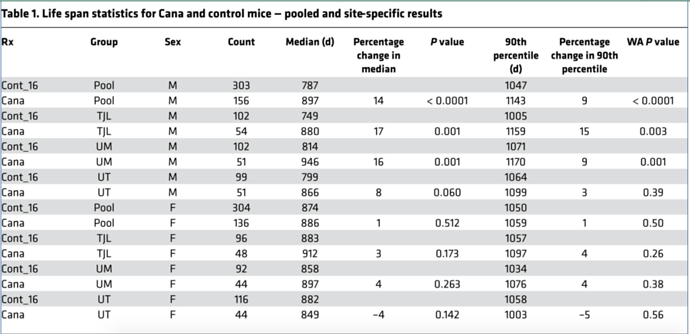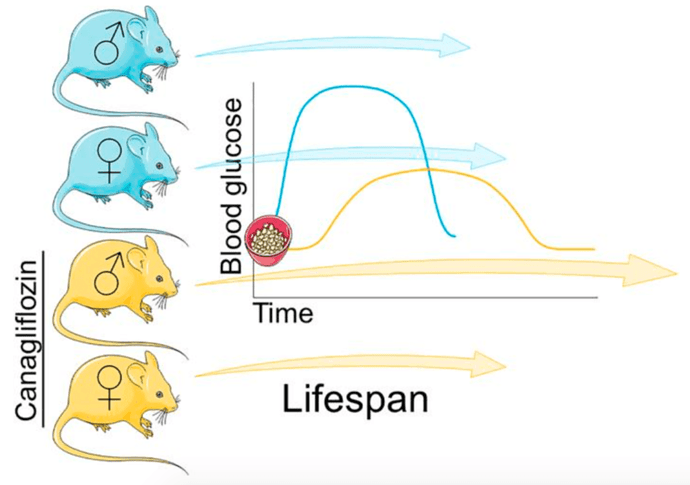While there are probably hundreds of compounds, if not thousands, that have some kind of evidence supporting the idea that they may provide some sort of anti-aging benefits, most of them have at most been tested only in lower level organisms (e.g. flies, worms, etc.), not in large, repeatable double-blind, placebo controlled studies in mammals.
Its mildly interesting to see a drug or supplement increasing the lifespan in a fly (here for example), or c.elegans worm, or even a mouse in a single study. But it starts to get a lot more interesting when the compound is a drug that is already FDA approved, has been used for years by humans, and there are well-designed, placebo controlled studies which have been duplicated in a number of different labs with similar results. And even better when the results show a relatively large increase in lifespan (e.g. 10%+), with a large number of subjects, that suggests that the results are well outside the boundaries of random chance. This is the type of information that suggests the compound is much more likely to work in humans.
There are very few anti-aging compounds that meet this high bar of validation. The following are all drugs that have been put through the National Institute on Aging’s Intervention Testing Program (ITP). This is the project that tests compounds in rigorous three-site, large sample size, placebo-controlled studies for lifespan extension in mice.
Other Compelling anti-aging drugs:
Drugs tested late in life by the ITP
The ITP has tested 3 drugs “late in life” and found them to be successful in extending lifespan
- Rapamycin works just as well late in life as starting it early;
- Acarbose works about half as well as an early start; and
-
17α-Estradiol seems to work just as well in late middle age;
- See this ITP paper on acarbose and 17α-Estradiol
Acarbose
- The initial paper was giving acarbose starting at four or five months of age
- Then they repeated the study it but starting at 16 months of age
- It worked half as well as acarbose started in youth
- There was statistically significant change in the maximum life span in both sexes
- And a statistically significant change in the males with median lifespan
17α-Estradiol
- 17α-Estradiol only works in males
- The newest findings from the ITP—just now at the last stages of revision—shows that if you start it at 16 months of age in males, it’s just as good as if you start it at an earlier age
- Additionally, Mike Garratt, Sharlene Day, and John Herrera have already published a paper using these same mice treated with 17α-Estradiol, where they started at 16 months
- It resulted in their muscles getting stronger, improved glucose tolerance, and positive changes in muscular structure
ITP studies – 17α-Estradiol
- The first attempt—cohort 5—used a low dose (4.8 ppm) and it extended median survival in males, but not maximum
- In the ITP study—cohort 7—they then gave a dose 3x higher (14.4 parts per million) and it extended the measure of maximum longevity , as well as median longevity at all three sites for male mice, but not for females
- In fact, the males not only lived longer than regular old males, they lived longer than regular females
So even after the impressive ITP findings, it hasn’t been pursued as an investigational new drug?
- “I don’t know” says Rich, “Certainly nothing has come to my attention about its being investigated.”
- There is an awful lot of attention to developing novel estrogenic compounds
- “I’ll bet a great chunk of it is kept quiet by pharmaceutical firms”
Canagliflozin (an SGLT2 inhibitor): exploring the impressive lifespan results in male mice [1:35:45]
SGLT2 inhibitors
- Canagliflozin is in the class of drugs known as SGLT2 inhibitors
- SGLT2 inhibitors has been around for a while and is used pretty readily in patients with type 2 diabetes as it blocks the re-uptake of glucose so that more glucose is excreted in the urine
- It affects the process in the kidney that deals with very high glucose levels without having much scope for causing toxicity
Results of the ITP study
Canagliflozin extends life span in genetically heterogeneous male but not female mice
- Increased median lifespan in the male mice by 14%, maximum extension of 9%
- But had no effect on the females
Figure 11. Lifespan statistics for Cana and control mice. [source]
Any insight into differential plasma levels between the males and females?
- The females actually had slightly higher levels than the males, meaning the absence of an effect in females is not explicable on the idea that they don’t get the drug into their blood
What could explain the sex-specific difference in the effect?
- When you take this together with the acarbose results, you’re led to the inference that something about aging in the male mice depends a lot on staying away from really high glucose levels
- But whether that means that high glucose in the males triggers a circuit in the hypothalamus, which is bad for you or something, is just a hypothesis
Cancer in mice
- Cancer is the predominant cause of death in these mice (about 80% of deaths)
- The leading cause for both males and females is hematopoietic cancers
- For females,
- the second leading cause is mammary cancer
- the third leading cause is either liver cancer or a fiber sarcoma
- In the males,
- the second is lung cancer
- And third is also liver cancer or fiber sarcoma (like the females)
-How much is hematopoietic in each?
-
About 30% of the deaths
-
These facts are counterintuitive based on human data: in humans, the mammary cancers would be quite glucose and insulin sensitive, whereas the lung would not be, so you would actually expect the opposite if that were true in mice (meaning you’d think the females to disproportionally have the benefit)
-
But it’s also possible that the glucose excursions are working on an anti-cancer defense, some aspect of immune defenses
-
Or… it could be—and this is Rich’s hope—that the glucose specific excursions are modifying some fundamental, still undiscovered element of the aging process in the hypothalamus
Figure 12. Graphical abstract of blood glucose response. [source]
- Maybe it has to do with the susceptibility of the hypothalamus to inflammatory change differentially in males than in females
- And that this nebulous change has an impact on the cancer, or an impact on anti-cancer defenses or something
- In Rich’s view, these hypotheses are equally likely to be true, but at present, none of it gives us much of a hint as to why these drugs have a much more striking effect in the male mice
-Did you see the same effect here that you did with acarbose in that the hemoglobin A1C was unaffected?
- Rich’s recollection is that there was no difference in the effect on hemoglobin A1C
- This is surprising because it is affected in human diabetics
Summarizing what we know about canagliflozin :
- We don’t know whether the positive effect of canagliflozin is due to its impact on glucose, SGLT2, or SGLT1
- The literature is showing, for example, that SLGT-2 inhibitors have an effect on tumors specifically, and other things like heart attacks, independent of whatever’s happening in terms of glycemic control
- The shortest, simplest explanation—that the benefits are due to canagliflozin’s effect on glucose—may not be right. — “There are other ideas that deserve a lot of exploration .”
-
- the cardioprotection, renal protection, obviously the glycaemic benefits are all pretty exciting.”

